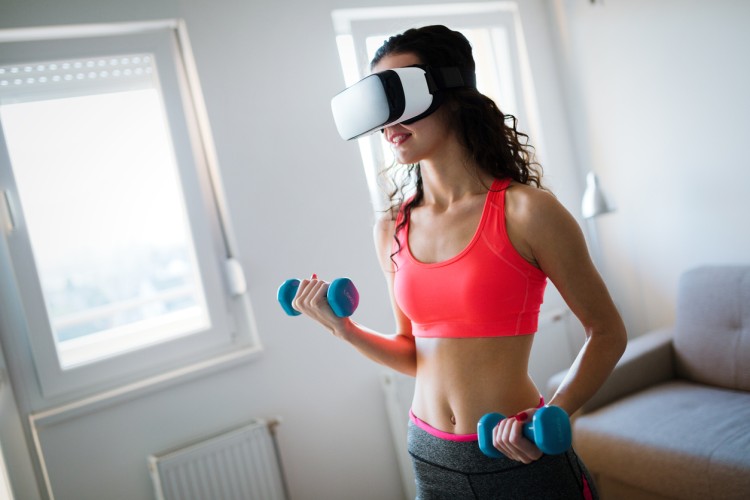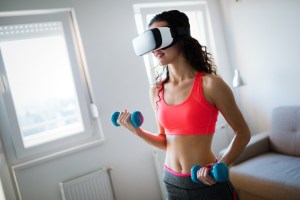Growth of Virtual Exercise: The Fitness Industry After Coronavirus

As recently as 2018, according to the Global Health & Fitness Association, the fitness industry was worth an estimated $94 billion — a valuation that fluctuated wildly with the emergence of COVID-19 in 2020. Since then, fitness brands and gym chains have scrambled to adapt to a new reality where digital, remote exercise options replaced traditional in-person workouts. ClassPass, one of the world’s largest distributors of remote class options to fitness clubs, currently has over 30,000 club partners in the U.S. alone, with a presence in over 27 other countries, demonstrating the demand for the ability to work out from anywhere.
As fitness executives accept that virtual exercise is becoming a permanent fixture rather than a passing trend, new methods of fitness training, such as live video classes and home workouts, will become more common. These forms of training will need to be guided by fitness professionals who understand the relationship between health and technology in the modern era, something a dedicated education in exercise science can offer to aspiring fitness experts.

Video Classes and Home Workouts
Video classes and home workouts were around before COVID-19, but the pandemic helped popularize them. According to a 2020 study by ClubIntel, 54% of 2,000 surveyed individuals either froze their gym memberships or canceled them altogether. This, combined with the mass closing of gyms in the months following the initial lockdown, allowed existing producers of virtual exercise content (such as fitness-centric YouTube channels) to fill the void with their own home workouts. As a result, online fitness enthusiasts helped audiences keep up their routines in spite of the drop in in-person attendance.
The shift to digital platforms allowed people to customize their workouts more than they might in a gym class, since they could form playlists of different workout types to target particular fitness goals.
But that wasn’t the only change to fitness: The lack of gym equipment at home paved the way for bodyweight exercises, isometric routines, yoga, and improvised workout tools to take center stage. People were now training their bodies in ways they might never have before, improving their understanding of how to maintain fitness lifestyle.
A More Holistic Approach to Health
A hybrid approach to physical fitness that includes in-person attendance and virtual exercise options is only the beginning of the move to a more diverse health experience. As COVID-19 lockdowns end and more gyms reopen to the public, fitness facilities are shifting focus. Before the coronavirus impacted the fitness industry, many people primarily saw the gym as a means to improving physical health. The new gym experience hopes to see fitness locales as places of social connectivity, mental health stability, and dietary guidance, all feeding into a more holistic approach to health beyond just physical exercise.
Classes, teams, and other extracurricular options will help create the communal experience, but technology will also play a key role. Chiefly, gyms are increasingly using remote classes to include members from across the world and allow people to stay connected, but many chains also offer software that can help track data and goals. For example, a variety of smartwatches track heart rate, calorie loss, macros, and more, many of which can be tied to gym-specific apps. Technology like this will allow people to stay on target with nutritional goals and be more aware of their total health experience.
The Future of Exercise
Lockdowns in the fitness industry during coronavirus created a rare opportunity for technology to introduce new software and tools into the lives of those who sought to maintain or improve their physical health. But one specific kind of cutting-edge technology could be waiting over the horizon.
While virtual reality has seen development in the gaming industry for several years, its potential to break up routines and diversify experiences means it could be entering the fitness industry sooner rather than later.
A virtual reality platform, which replaces a person’s visual and auditory environment with a digital one, already exists as a supplementary fitness option, but as the technology develops, some professionals believe it could become a primary exercise modality. With its ability to gamify activities, reduce monotony, connect people, and reduce self-consciousness, this avenue of virtual exercise technology could create exciting new ways to improve physical and mental health.
Your Next Step in a New Fitness Frontier
As the fitness industry reinvents itself, new professionals can find opportunities on the ground floor of a new frontier. The form exercise will take in the coming years is uncertain, full of potential, and exciting for those passionate about health and fitness.
If you’re an aspiring fitness professional looking to bring your passion to life, you know the potential that technology and virtual exercise have for shaping this industry’s future identity. With the right education, such as Maryville University’s online Bachelor of Science in Exercise Science, you can carve your path in the fitness industry with a confidence born of knowledge. Featuring courses such as Adaptive Physical Activity, Virtual Fitness and Health, and Nutrition of Exercise Management, the Maryville program is designed to put you at the forefront of the exercise revolution. Embark on your new career today.
Recommended Reading
At-Home Workout Ideas for Students
Exercise and Nutrition for College Students
Fitness Tips to Improve Mood, Focus, and Overall Mental Health
Sources
Bloomberg, “How COVID-19 Has Permanently Changed the Fitness Industry”
CNN, “The $94 Billion Fitness Industry Is Reinventing Itself as COVID-19 Spreads”
Men’s Health, “The Future of the Post-Pandemic Gym”
Mindbody Business, “Virtual Workout Trends During Shelter at Home”

